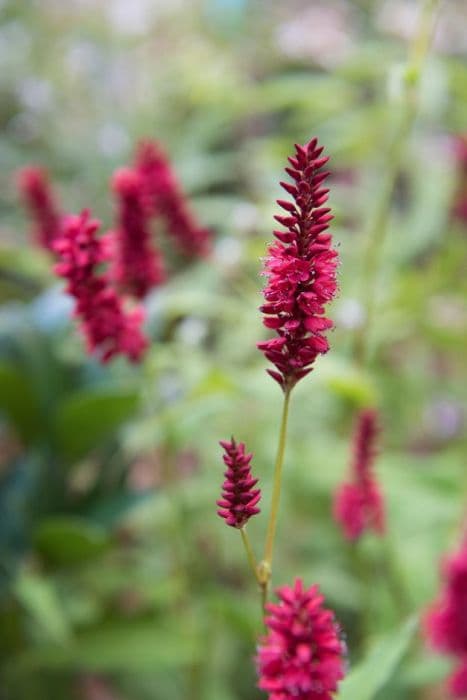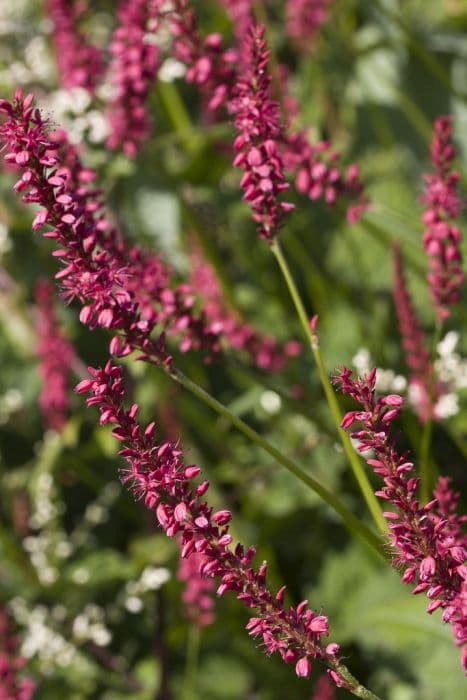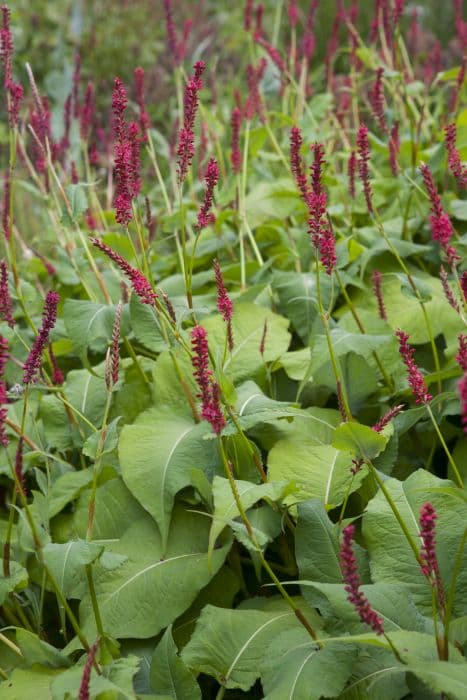Red bistort Persicaria amplexicaulis 'Blackfield' (PBR)

ABOUT
The plant known as 'Blackfield' is adorned with striking deep red to almost blackish flowers that bloom atop slender, upright stems. These flowers are elongated, spike-like clusters, adding a touch of drama with their dark coloring. The foliage beneath the blooms is a lush green, forming a dense clump with broad, oval-shaped leaves that offer a classic backdrop to the vivid flower spikes. Throughout the blooming season, from summer into fall, 'Blackfield' continuously produces these richly colored flowers, attracting pollinators like bees and butterflies. The contrast between the dark flowers and the bright green leaves is striking, making it a standout in any garden setup where it can lend a vertical accent with its flower spikes. Overall, the 'Blackfield' cultivar combines the beauty of verdant foliage with the unique allure of its almost black flowers.
About this plant
 Names
NamesFamily
Polygonaceae
Synonyms
Red Bistort, Mountain Fleece, Knotweed
Common names
Persicaria amplexicaulis 'Blackfield' (PBR).
 Toxicity
ToxicityTo humans
The plant known as Bistort is not commonly listed as a toxic plant to humans. Therefore, if ingested, it is not typically expected to lead to serious poisoning. However, as with any plant, individual allergic reactions or sensitivities may occur. If symptoms develop after ingestion or contact, it is recommended to consult a healthcare professional.
To pets
For the Bistort, there is no widespread documentation or evidence that suggests significant toxicity to pets such as cats and dogs. However, ingestion of non-food plants can sometimes cause gastrointestinal discomfort or upset in pets. If your pet consumes parts of the plant and shows signs of distress such as vomiting, diarrhea, or unusual behavior, it is advised to contact a veterinarian.
 Characteristics
CharacteristicsLife cycle
Perennials
Foliage type
Deciduous
Color of leaves
Green
Flower color
Dark red
Height
3-4 feet (0.9-1.2 meters)
Spread
2-3 feet (0.6-0.9 meters)
Plant type
Herb
Hardiness zones
5
Native area
Himalayas
Benefits
 General Benefits
General Benefits- Attracts Wildlife: The Persicaria amplexicaulis 'Blackfield', commonly known as Bistort, produces flowers that attract beneficial insects such as bees and butterflies to the garden.
- Low Maintenance: Bistort is considered low maintenance, requiring minimal care once established, making it a convenient option for gardeners.
- Drought Tolerant: Once established, it has good drought tolerance, reducing the need for frequent watering.
- Long Flowering Period: Bistort has a long blooming period from mid-summer to fall, providing long-lasting color and interest in the garden.
- Easy to Grow: This plant is relatively easy to grow in comparison to other perennials and can thrive in a range of garden conditions.
- Good for Borders: With its vertical growth habit and attractive spikes of flowers, Bistort is excellent for adding structure and height to flower borders.
- Seasonal Interest: Its striking dark red flowers and green foliage add visual interest throughout the growing season.
 Medical Properties
Medical PropertiesThis plant is not used for medical purposes.
 Air-purifying Qualities
Air-purifying QualitiesThis plant is not specifically known for air purifying qualities.
 Other Uses
Other Uses- As a natural dye: The leaves and stems of Persicaria amplexicaulis ‘Blackfield’ can be used to create natural dyes for fabrics, providing a range of earthy tones to textiles.
- In flower arrangements: The dark red, almost black flowers of this plant make stunning additions to floral arrangements, especially when aiming for a dramatic or moody aesthetic.
- As a photography subject: The unique coloration and structure of the ‘Blackfield’ variety offer an interesting subject for photographers specializing in botanical and nature photography.
- As a teaching tool: The plant can be used in educational settings to illustrate plant growth habits, pollination by insects, and seed dispersal mechanisms.
- Erosion control: Its dense growth habit makes it suitable for planting on slopes or areas prone to erosion to help stabilize the soil.
- As a natural insect repellent: While not as strongly scented as other plants, the foliage may have some properties that deter certain insects when planted around outdoor living spaces.
- In craft projects: Dried flowers of Persicaria amplexicaulis ‘Blackfield’ can be used in crafting, such as making bookmarks or in potpourri mixtures.
- Container gardening: This versatile plant can also be grown in large containers, providing a striking focal point on patios or balconies.
- As a companion plant: It can be used in mixed borders to complement other plants, its dark flowers accentuate the colors of surrounding blooms and foliage.
- In pond-side planting schemes: With its moisture-loving nature, this cultivar makes an excellent addition to planting schemes around ponds or water features.
Interesting Facts
 Feng Shui
Feng ShuiThe plant Bistort is not used in Feng Shui practice.
 Zodiac Sign Compitability
Zodiac Sign CompitabilityThe plant Bistort is not used in astrology practice.
 Plant Symbolism
Plant Symbolism- Resilience: The Mountain Fleece is known for its ability to adapt to various soil conditions and its resilience in different climates, symbolizing the capacity to persevere through challenges.
- Connection: With its dense spikes of flowers that attract pollinators, Mountain Fleece represents the idea of connection and interaction within nature, reminding us of the importance of relationships in our own lives.
- Protection: The robust nature of Mountain Fleece, which allows it to grow and provide cover for smaller creatures, symbolizes shelter and protection.
 Water
WaterThe Red Bistort, commonly known as Persicaria amplexicaulis 'Blackfield', should be watered regularly to keep the soil consistently moist, particularly during dry periods in summer. It is best to water deeply once or twice a week, providing around 1 to 1.5 gallons per plant per watering session, depending on soil type and weather conditions. Avoid overhead watering to prevent leaf diseases; instead, water at the base of the plant. During the winter months, reduce watering as the plant's water needs decrease. Monitor the soil moisture level frequently to prevent overwatering, which can lead to root rot.
 Light
LightRed Bistort thrives in full sun to partial shade conditions. It prefers a spot that receives several hours of direct sunlight daily but will tolerate some light afternoon shade, especially in hotter climates. An ideal location would get morning sun and some protection from the intense heat of the afternoon.
 Temperature
TemperatureRed Bistort is hardy and can tolerate a range of temperatures but thrives between 60 to 75 degrees Fahrenheit. It can survive minimum winter temperatures down to about -20 degrees Fahrenheit, making it suitable for growing in USDA hardiness zones 4 through 9. Avoid planting in areas where temperatures frequently exceed 85 degrees Fahrenheit without providing some shade, as extreme heat can affect the plant's growth.
 Pruning
PruningPrune Red Bistort to remove spent flower stalks and encourage a second flush of blooms. Light pruning can be done throughout the growing season as necessary. The best time for a more thorough pruning is in late fall or early spring, when you should cut back the foliage to the ground to maintain a tidy appearance and promote healthy new growth in the spring.
 Cleaning
CleaningAs needed
 Soil
SoilRed bistort 'Blackfield' prefers a soil mix consisting of garden soil, compost, and organic material such as leaf mold to ensure good drainage and fertility. The soil pH should ideally be between 5.5 and 7.0.
 Repotting
RepottingRed bistort 'Blackfield' typically does not require frequent repotting and can be left undisturbed for several years as it is a hardy perennial that spreads through rhizomes.
 Humidity & Misting
Humidity & MistingRed bistort 'Blackfield' is adaptable to average outdoor humidity levels and does not have specific humidity requirements, thriving in the natural humidity found in its growing zones.
 Suitable locations
Suitable locationsIndoor
Ensure bright light, moist soil, and good air circulation for indoor growth.
Outdoor
Plant in partial shade, moist, well-drained soil; mulch.
Hardiness zone
4-7 USDA
 Life cycle
Life cycleBistort 'Blackfield' emerges in spring as shoots from its rhizomatous root system. As temperatures warm, it develops robust stems and lance-shaped leaves, entering its vegetative growth phase. Summer brings spikes of tiny, deep red flowers that attract pollinators and are held above the foliage, marking the reproductive stage. Following pollination, seeds develop and can be dispersed to propagate new plants. As autumn approaches, Bistort 'Blackfield' begins to die back as it enters dormancy, with above-ground parts withering, but the rhizomes survive underground. With the return of spring, the cycle restarts as new growth emerges once again from the rhizomes.
 Propogation
PropogationPropogation time
Late summer
Persicaria amplexicaulis 'Blackfield', commonly known as Red Bistort or Mountain Fleece, can be propagated by division, which is the most popular method for this particular plant. The optimal time for dividing Red Bistort plants is in the spring, just as new growth begins to emerge. Gardeners should carefully dig up the plants, taking care to keep the root ball intact. With a sharp knife or spade, the root ball is then divided into smaller sections, making sure each new piece has several growing points and a portion of the root system. These divisions should be immediately replanted in a pre-prepared hole and watered thoroughly. The spacing between new plants should be about 18 to 24 inches (45 to 60 centimeters) to allow enough room for growth. Divisions will typically establish themselves quickly and can flower in the same season if done early enough in the spring.









